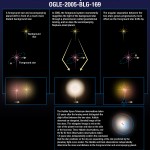W. M. Keck Observatory press release…
The W. M. Keck Observatory in Hawaii and NASA’s Hubble Space Telescope have made independent confirmations of an exoplanet orbiting far from its central star. The planet was discovered through a technique called gravitational microlensing. This finding opens a new piece of discovery space in the extrasolar planet hunt: to uncover planets as far from their central stars as Jupiter and Saturn are from our sun. The Hubble and Keck Observatory results will appear in two papers in the July 30 edition of The Astrophysical Journal.

Microlensing occurs when a foreground star amplifies the light of a background star that momentarily aligns with it. If the foreground star has planets, then the planets may also amplify the light of the background star, but for a much shorter period of time than their host star. The exact timing and amount of light amplification can reveal clues to the nature of the foreground star and its accompanying planets.
“Microlensing is currently the only method to detect the planets close to their birth place,” said team member, Jean-Philippe Beaulieu, Institut d’Astrophysique de Paris. “Indeed, planets are being mostly formed at a certain distance from the central star where it is cold enough for volatile compounds to condense into solid ice grains. These grains will then aggregate and will ultimately evolve into planets.”
The system, cataloged as OGLE-2005-BLG-169, was discovered in 2005 by the Optical Gravitational Lensing Experiment (OGLE), the Microlensing Follow-Up Network (MicroFUN), and members of the Microlensing Observations in Astrophysics (MOA) collaborations—groups that search for extrasolar planets through gravitational microlensing.
Continue reading “Telescopes Team Up to Find Distant Uranus-Sized Planet Through Microlensing”
